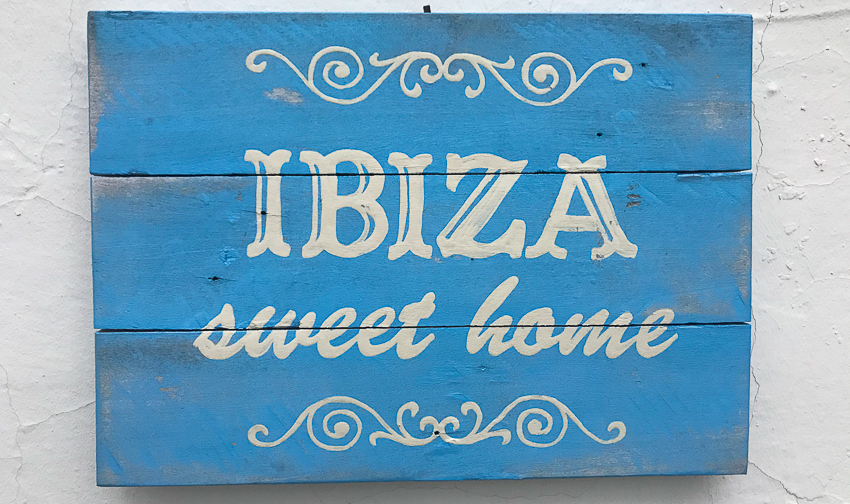Looking for Authentic Ibiza The authentic Ibiza exists, it is alive and well. Its beauty provides an all-embracing feeling of peace and content when you discover it. Ibiza is about letting go. Immerse in a world of old traditions mixed with hippie culture that will take you away from daily worries. In this article, first we have chosen a "bouquet" of locations to stroll along in true traditional Ibiza where you will discover some symbols of Ibizan authenticity. Then, we taste the local food tradition and some lovely eateries. We finish with Ibicenco dress making and some thoughts about the hippie culture still present on the island. If you are into discovering the authentic spirit of Ibiza, most of this can be done in 2 days... or in 2 years if you decide to stay. Relax and enjoy the moment.
Related article: Living in Ibiza
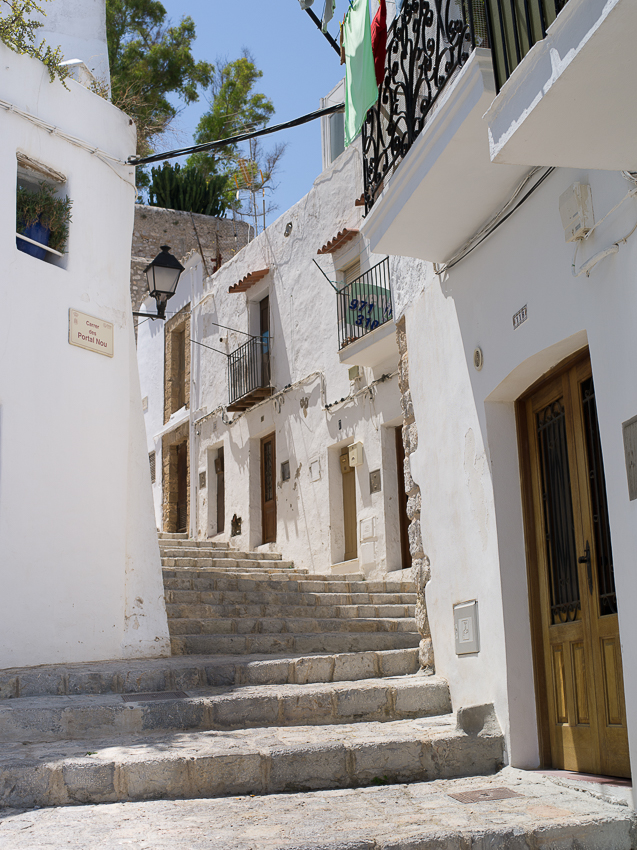
DALT VILA – IBIZA OLD TOWN HILL
In 1999, Ibiza Old Town was declared A UNESCO World Heritage site. The intact 16th century fortifications of Ibiza bear unique witness to the military architecture and engineering of the time, reminiscent of Renaissance aesthetics. This unique melding of Italian-Spanish styles became highly influential in Mediterranean architectural trends, especially in the construction and fortification of towns in the New World.
To explore this idyllic site, you’re better off on foot, in sensible shoes, traversing the winding, steep, stone cobbled streets to enjoy the magnificent views from the breaks in the high ramparts and the vast terraces at each level (Dalt Vila actually means ‘High Town’). The dramatic main entrance draws your eyes upward toward a slope, crossing a drawbridge through the Portal de Ses Taules, flanked by mighty statues in Roman stone, welcoming you to an ancient paved stone courtyard, and then drawing you to Plaza de Vila, the main square.
The other entrance, Portal Nou (reached from behind the Plaza del Parque) offers a more gradual ascent. A leisurely pace is best, as there’s so much fascinating detail at which to marvel. Traditionally black clad Ibicencos, untouched by time, go about their lives in the ancient, Gothic Catalan buildings hugging the streets. Sturdy wooden doors reveal spacious stone courtyards and private chapels. The gift shops and art galleries on the walk up to the cathedral are treasure troves of unusual and unique works by local artisans.
The town is brimming with history. Two of the most prominent figures from the island’s past have monuments in their honor here. Look out for the bronze statue of Isidor Macabich, a priest and historian who was the first person to chronicle the history of Ibiza in detail. In Plaza de Espana, there is a monument to Guillem de Montgri who, in 1235, conquered Ibiza for King Jaime I. This reclining statue is a replica of the tomb of Guillem de Montgri in Gerona.
As you are wandering around Dalt Vila, don’t be afraid to peer through the tall doorways if they are standing ajar. This is a town of contrasts and surprises, so quite often you will find a pretty courtyard, or gift shop selling local crafts. On Calle Conquista, one comes across a display of hand-prints of celebrity guests to Ibiza.
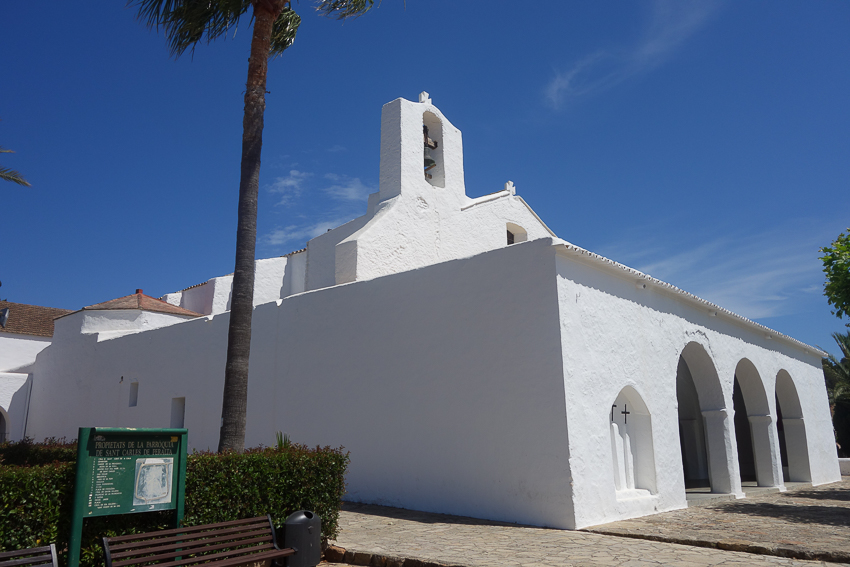
SAN CARLOS
7 km from Santa Eulalia lays the charming village of San Carlos. This “pueblo” kept a traditional feel. It is the northernmost town in the municipality of Santa Eulalia and only has a few street, many houses are scattered in the fields of almond, carob and fig trees. Its whitewashed church from 1785 has a single bell tower placed to the left. The old building is surrounded by gardens where you can see the old communal village well. In the surroundings of San Carlos we recommend you visit "Es Trull de Ca N'andreu" (oil mill) a 17th century museum estate that opens its doors for private visitors. The trull dates from 1775 and is one of the few preserved on the island. You can see old farm equipment , plows, millstones, utensils for making wine, tools to make the traditional footwear, etc.
San Carlos welcomed the hippy movement in the 1960s. Its influence continues to be felt in the town and its surroundings. The famous Bar Anita preserves the mailboxes and the phone booth, ways of hippies to communicate with the outside world. Inhabitants called the hippies “peluts” and they often called Anita the woman who ran the bar “mom”. If you visit Sant Carlos in the month of November, you have to attend the squid party with tapas tasting based on this sea food, country dance, folk parades, etc. From Sant Carlos you can visit many beautiful and interesting coves such as Aguas Blancas, Cala LLenya, Cala Mastella and Cala San Vicente.
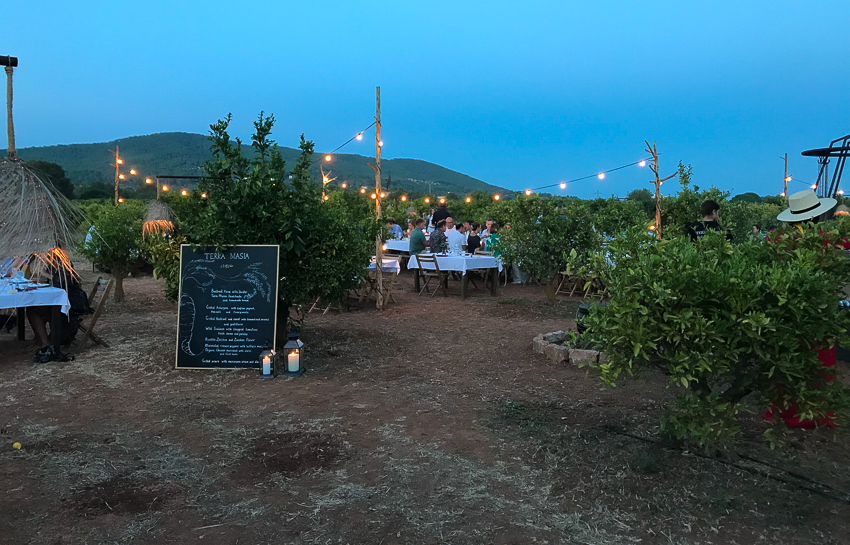
SANTA GERTRUDIS
Located 12 km from Ibiza in the centre of the island, Santa Gertrudis is a prolific fruit and vegetable producing and trading region. The pedestrian streets in front of the lovely 18th century church have become a meeting point for working residents. This is one of the reasons the small town lives all year with bars, restaurants and shops. Off-season some of these are open on weekends only. The main charm of Santa Gertrudis lies in its environment of fields that can be hiked on foot or visited by bike or car. There are irrigated cultivation fields thanks to the abundance of water that exists in the subsoil and that is stored in a succession of pools built by the farms.
SANTA INÉS
Santa Agnés de Corona, in the northwest of the island, is a small town with few houses around a pretty church. Its cultivated area is called "Es Pla de Corona" and is famous for the cultivation of almond trees. Walking around here in February is a charm since the white and pink and white mantle of the valley is spectacular for 4 to 5 weeks.
From Santa Inés there is a route to do to the “Gates of Heaven”, a cliff overlooking the sea in the middle of a pine forest and where magnificent twilights and the islets of Ses Margalides are seen.
BENIMUSSA
Not far from San Antonio, the Benimussa Valley is one of the picturesque farming areas in Ibiza. Small patches of farmlands where the eye can see, in the plains and at the foot of the mountain, where carob, fig, almond and olive trees abound. It takes its name from the Benimussa farmhouse which in the 14th century was one of the most important on the island.
The best route to access Benimussa is to come from San Rafael, take the Camí des Fornás (behind the fire station).
The hills are crowned by thick pine forests and strewn with some large houses, most of which are still occupied by the same families since centures. They are separated from each other by stone walls. At the beginning of the road is the plantation of Joan Benet, a pioneer producer of olive oil. In the surroundings there are some interesting country monuments such as the old wells d’en Benet and Benimussa. Folk dances are performed at the Capelleta d’en Serra, this small hermitage built at the beginning of the 20th century by Vicent Serra who installed a ceramic Christ inside. It is a place of pilgrimage and inside there are notebooks to write your wishes.
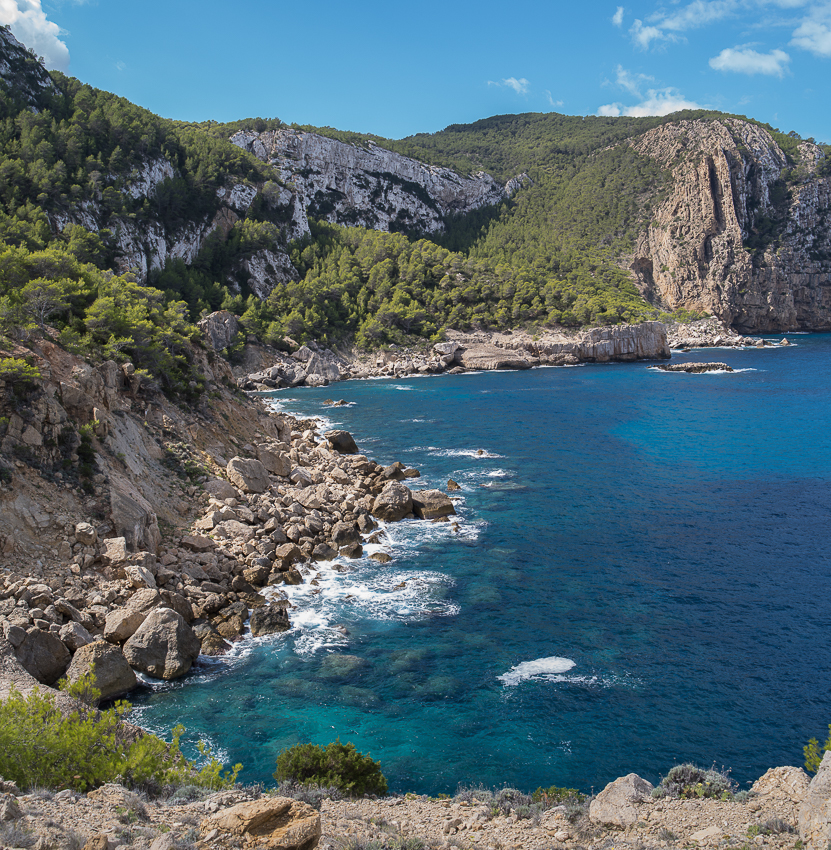
SAN MATEU D’ALBARCA
Located in El Pla d’Albarca about 18 km north of Ibiza, it is characterized by its lemon, orange and almond trees, and the best vineyards in Ibiza. The urban nucleus dates from the end of the 18th century with the construction of the church. In December, a popular torrada (roast meat and sausages) is held outdoors, where local wine called Payés wine is tasted.
It is interesting to walk the Via Crucis, a dirt road near the church, and also to stroll through the nearby fields and the beautiful vermilion-colored earth. A short distance from the town, do not hesitate to hike to the coast of Cala d’Albarca. A 45 minute walk to discover the Es Amunts natural reserve with the 200 m high Rubió and Albarca cliffs. The path starts behind the bar Es Camp Vell. Another excursion is to go to the watchtowers Ses Torres d’en LLuc in the middle of the stretch of coast that connects Santa Inés with Sant Mateu. This archaeological site with two oval-shaped towers and some walls was part of a fortress of which only the bases remain. From there you can see the Cala d'Albarca at a walking distance of 1.2 km.

IBIZA FOOD
Simplicity with authentic taste, meat cold cuts, and local goat cheese are of any light traditional meal in Ibiza, especially in the hot summer months. For starters you taste country bread (pan payés) dipped in “aioli,” a stronger white emulsion of garlic in olive oil. To accompany your white or rosé wine at apero time, try the local goat cheese with a rosemary, pepper, or paprika crust, or a Catalan “pan con tomate” - simple bread spread with squashed tomato - and Pimiento del Padrón, a pan-fried small green sweet peppers with sea salt.
Flavorful terroir ingredients make for Ibiza’s delightful cuisine. Local cuisine is Spanish Mediterranean, including the influences of North Africa, like Morocco, and the Middle East, like Lebanon. Enjoy common culinary dishes of the island like “bullit de peix” (fish stew with saffron) “sofrito pagès” (pork, lamb and chicken cuts in sweet peppers and garlic), “arroz a la marinara” (seafood rice) and “arroz de matança” (rice with pork). The famous Spanish paella, a large flat pan of saffron seasoned seafood rice, has its local version: “fideua” with small pasta replace rice.
As to vegetables and fruits, due to the favorable humid yet warm climate, foodies can experience in summertime the luxury of tasting local terroir produce at a time of natural ripeness. The freshly caught fish we taste are grouper, tuna, john dory or skate. Outstanding desserts include a tart made with goat and sheep cheeses and mint known as “flaó”; a pudding made of bread, milk and eggs called “greixonera”; and on important social occasions, it’s typical to try “pellets,” small ear-shaped cakes.
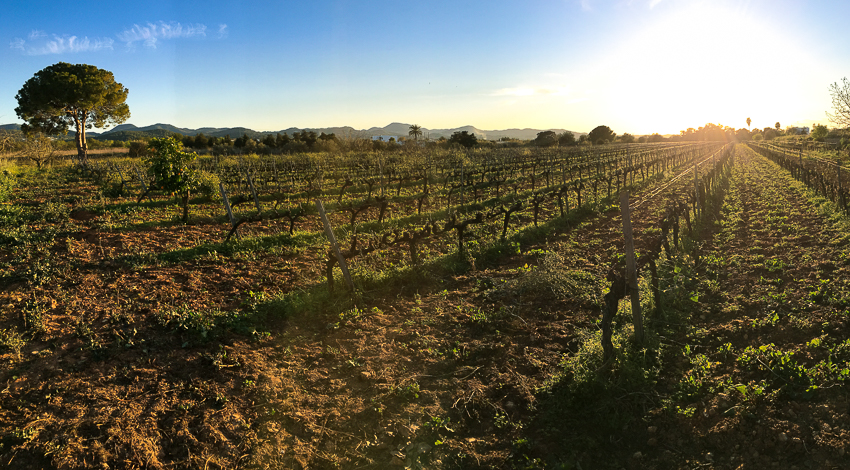
A few local wines of the IGP denominations such as “Tierra de Ibiza“ and “Formentera” are a pleasant surprise in white, rosé and red. Wines, native olive oil, and sea salt are harvested and produced here for thousands of years with knowledge passed down through the generations. We also find an array of fine sausages and cured ham, coffee, and herbal liquor. The cortado - an expresso with a dash of milk foam - is one of the local treats one should enjoy when in Ibiza.

Nowadays Ibiza has a multifaceted food offer. In addition to the local food tradition, a wide array of cuisines can be sampled next to the waves, under pinewoods in the countryside and in places vibrant with history. The affluence in the summer of many foodies interested in quality has driven up the standards. New eateries celebrate the spirit of the white island in its various shades from simpler decor to the utmost stylish. A lot of care is invested daily to offer a good experience, to prepare the restaurant’s cuisine, with attention to detail and quality of service.
Restaurants on the coast have specialized on fish and seafood dishes.

ADLIB FASHION
You cannot speak of Ibizan authenticity without evoking this clothing trend inspired by Ibizan tradition. Originally women in Ibiza wear black. For a more temperature-adapted way of life, the main color is the traditional all-white dress. At the base of the dresses are romantic and airy laces dresses, women's shawls, straw hats, and the esparto grass slippers and leather boots.
Ibiza Fashion Week was born in 1971 with the arrival of the hippie movement. Gradually the hippie fashion merged with traditional costumes and this new trend was called Adlib, that is, Ad Libitum or freedom. The Adlib catwalk returns every year to dazzle both Ibizans and tourists. The Yugoslav “princess” Smija Mihailovith played a key role as an ambassador for the new style throughout the world, her motto was “dress as you want but in style”. Adlib fashion is characterized by light pieces in puree white, hand-embroidered with handmade lace. Read more about about Adlib here: https://www.adlibibiza.es/en/ One of the prominent creative figures on the Adlib catwalk is local designer Charo Ruiz. She creates her seasonal collections and wedding dresses. Information: https://www.charoruiz.com
PERFUMES CAMPOS DE IBIZA
Campos de Ibiza creates perfumes with aromas of fruits and flowers harvested locally. Nowadays the offer has been expanded to oils, creams, home air fresheners, and candles. Campos are present in more than 20 countries.
Information about stores and products: https://www.camposdeibiza.com
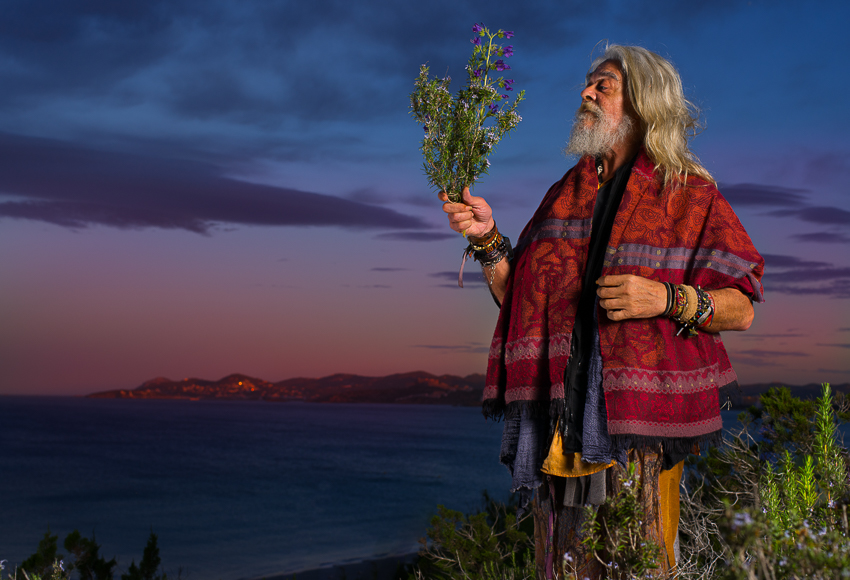
FLOWER POWER - THE HIPPIE CULTURE IN IBIZA Hippies started to settle in Ibiza in late 1960, the island being the ultimate place where they could hide away in peace, do some work, and wind down every summer. So much so that Ibiza came to be known as the “Hippie Island.” The spiritual connection between Ibiza and Asia is strong thanks to the hippy movement: hippies were traveling in the winter to India, Indonesia, and Bali, bringing back to the white island all sorts of riches and handiwork, along with the associated spiritual knowledge and practices. Hippies also introduced an active nightlife, worldwide gatherings of peace and friendship, sun-worshiping, and yoga to Ibiza.
The Hippie Culture is still alive in Ibiza although it is not as intense as the glory days of the 1970s. Nowadays, hippie boomers need a nest egg, evolved into entrepreneurs, and have turned some traditions into business for a more secure lifestyle. This shines through in the hippy markets held on the island where mostly handmade items, clothing, jewelry, and artifacts are on display. The biggest markets are in Es Canar on Wednesday and the Las Dalias on various days in San Carlos.

OFF YOU GO!
Autentic Ibiza is best discovered with the state of mind of the island: positivity and freedom. In your journey be ready that not everything will be 100% impeccably ordered and straight. This is exactly the point of being relaxed and enjoying the moment.

You are ready now to confidently go about discovering the true essence of Ibiza. We wish you lots of happy hours enjoying Ibiza in its simplicity and beauty! Related article: Living in Ibiza
Feel free to contact us we are happy to answer any of your questions!
